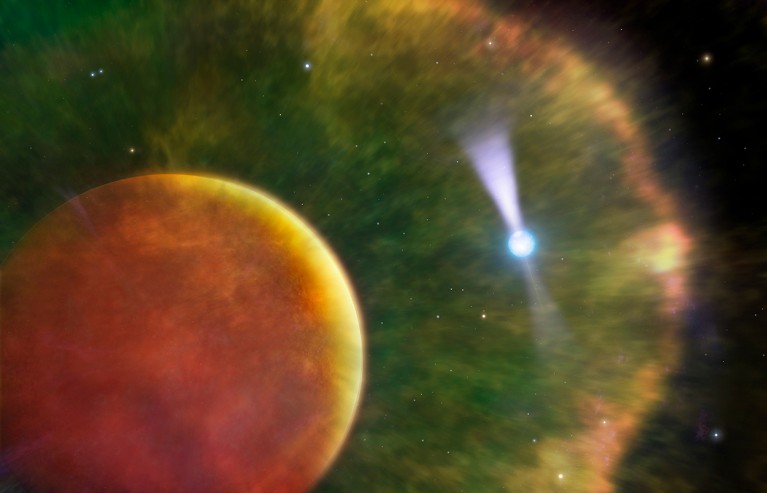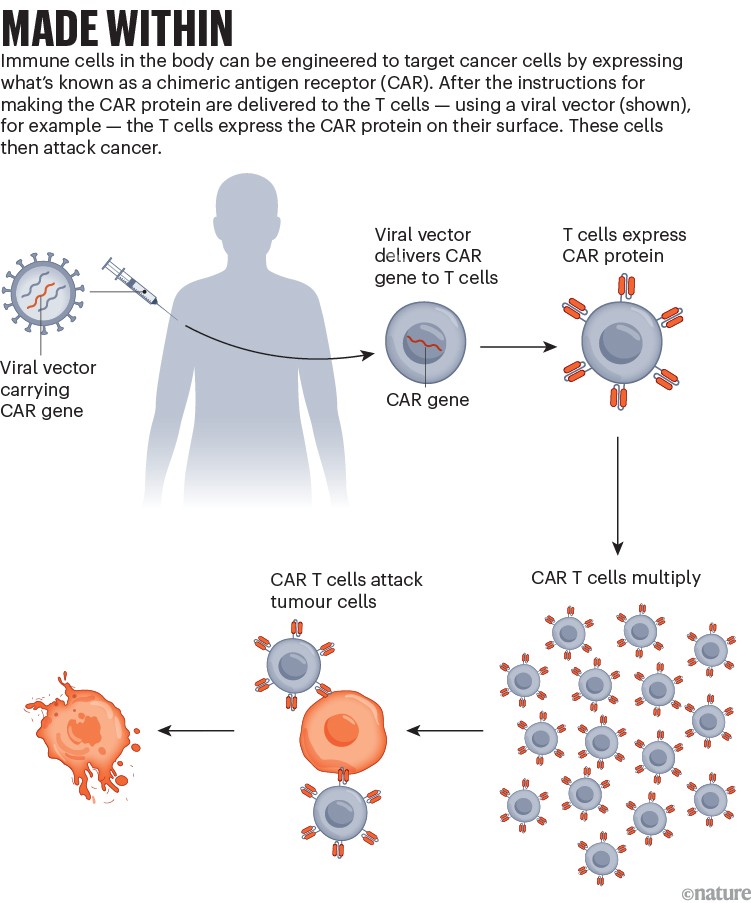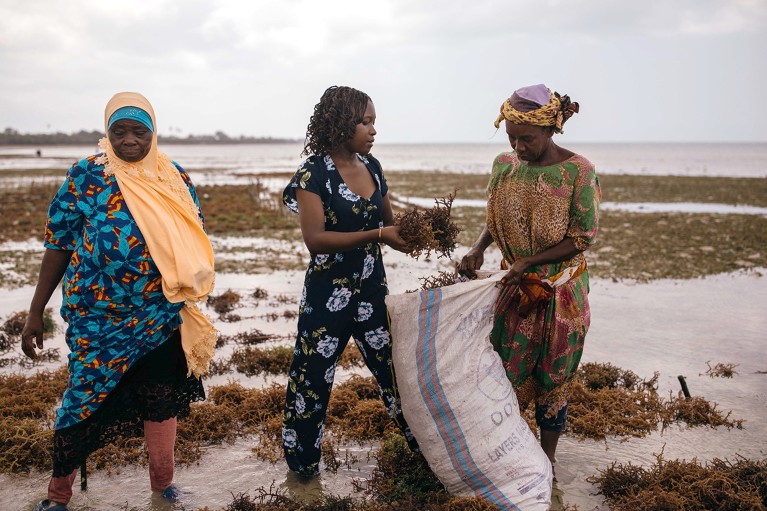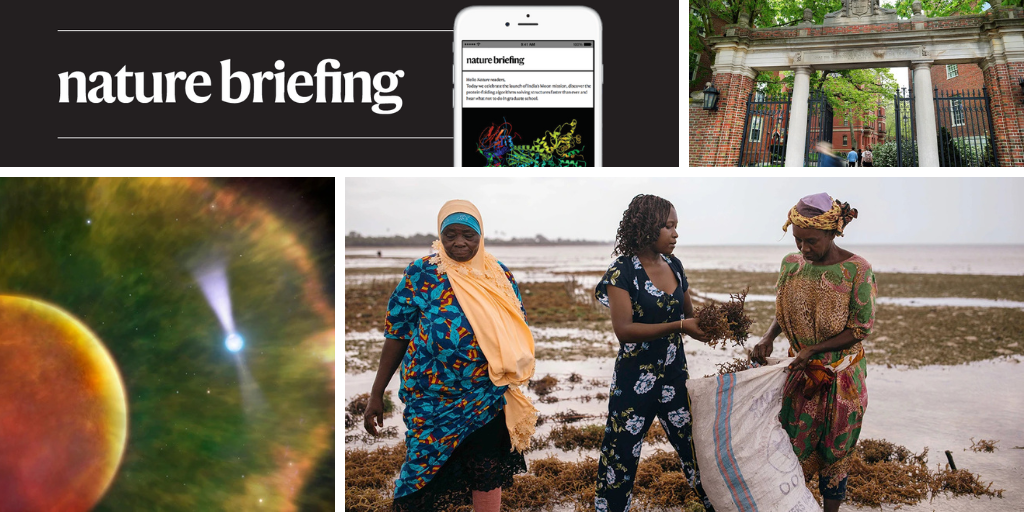You have full access to this article via your institution.
Hello Nature readers, would you like to get this Briefing in your inbox free every day? Sign up here.

An illustration of a ‘black widow’ pulsar (right) with its brown dwarf companion star (left).Credit: Mark Garlick/Science Photo Library
Astronomers have spotted hints of a long-theorized system of two stars in which a rapidly spinning neutron star has been engulfed by its larger companion star, which it then stripped to its core. The neutron star is a rare example of a ‘spider pulsar’ — one that consumes the material around a companion star, or causes it to scatter away by emitting powerful beams of radio waves. The detection sheds light on processes that give rise to the mergers seen by gravitational-wave observatories — involving two neutron stars, two black holes or one of each.
Over a six-week period across May and June, dozens of meteorologists are chasing ice-dropping storms across the US Great Plains in the hopes of solving some of the mysteries of hail. Namely, why some storms make monster hailstones whereas others drop only harmless fragments of ice. The field campaign, known as ICECHIP, will help scientists to understand how hailstones form and accumulate ice as they move through a thunderstorm, and what conditions create the most damaging hail. The results should help people to better prepare for damage from incoming hail, says meteorologist Ian Giammanco.
Features & opinion
Treatments that engineer a person’s own immune cells to attack cancer cells — known as chimeric antigen receptor (CAR) T cell therapies — have revolutionized blood cancer treatment. But there’s a catch: making CAR T cells in the lab is time-consuming and expensive, and the therapies are difficult to administer. Now, treatments are in the works that alter T cells inside the body. Human trials of these treatments are at early stages, but many researchers are excited about, and hopeful for, a simpler and more-widely usable version of CAR-T therapy.

Behavioural ecologist David Hughes was a scientific consultant on The Last of Us, the 2013 video game that inspired the hit TV show. The game that invited players to explore a world ravaged by a Cordyceps fungus — inspired by the real-world Ophiocordyceps unilateralis — that infects humans and takes over their brains. Hughes spoke to Nature about his experience consulting on the game and why COVID-19 changed our appetite for zombies. “I was really impressed by how much the game’s writers got into the science of it,” he says. “The writers were geeky, and understanding fungi is not complex, so they ran with it.”
Where I work

Amenipa Kyando (centre) is an aquatic scientist at the Aqua-Farms Organization in Dar es Salaam, Tanzania.Credit: Kang-Chun Cheng for Nature
Aquatic scientist Amenipa Kyando runs a development project that empowers women to secure a fair income from seaweed farming in Tanzania. “We train them to farm seaweed more productively and sustainably. We also show them how to turn their harvest into value-added products ranging from shampoos, body oils and scrubs, to nutritional powders and even hot sauce,” she says. “In Zanzibar, the 58 women we have worked with so far have increased their earnings per kilogram of seaweed from less than US$0.25 to $4.” (Nature | 3 min read) (Kang-Chun Cheng for Nature)
On Friday, Leif Penguinson was exploring the beautiful marble rock formations on General Carrera Lake in the heart of Chilean Patagonia. Did you find the penguin? When you’re ready, here’s the answer.
Thanks for reading,
Jacob Smith, associate editor, Nature Briefing
With contributions by Smriti Mallapaty
Want more? Sign up to our other free Nature Briefing newsletters:
• Nature Briefing: Careers — insights, advice and award-winning journalism to help you optimize your working life
• Nature Briefing: Microbiology — the most abundant living entities on our planet — microorganisms — and the role they play in health, the environment and food systems
• Nature Briefing: Anthropocene — climate change, biodiversity, sustainability and geoengineering
• Nature Briefing: AI & Robotics — 100% written by humans, of course
• Nature Briefing: Cancer — a weekly newsletter written with cancer researchers in mind
• Nature Briefing: Translational Research — covers biotechnology, drug discovery and pharma


